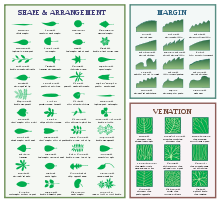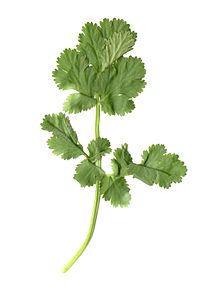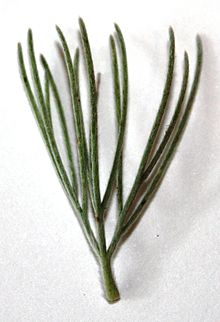- Leaf shape
-
In botany, leaf shape is characterised with the following terms (botanical Latin terms in brackets):
- Acicular (acicularis): Slender and pointed, needle-like
- Acuminate (acuminata): Tapering to a long point
- Acute: pointed, having a short sharp apex angled less than 90°
- Aristate (aristata): Ending in a stiff, bristle-like point
- Asymmetrical: With the blade shape different on each side of the midrib
- Bipinnate (bipinnata): Each leaflet also pinnate
- Compound: Not simple; the leaf is broken up into separate leaflets, and the leaf blade is not continuous
- Cordate (cordata): Heart-shaped, with the petiole or stem attached to the cleft
- Cuneate (cuneata): Triangular, stem attaches to point
- Deltoid (deltoidea) or deltate: Triangular, stem attaches to side
- Digitate (digitata): Divided into finger-like lobes
- Elliptic (elliptica): Oval, with a short or no point
- Falcate (falcata): Sickle-shaped
- Filiform (filiformis): Thread- or filament-shaped
- Flabellate (flabellata): Semi-circular, or fan-like
- Hastate, spear-shaped (hastata): Pointed, with barbs, shaped like a spear point, with flaring pointed lobes at the base
- Laciniate: Very deeply lobed, the lobes being very drawn out, often making the leaf look somewhat like a branch
- Laminar: Flat (like most leaves)
- Lance-shaped, lanceolate (lanceolata): Long, wider in the middle
- Linear (linearis): Long and very narrow
- Lobed (lobata): With several points
- Mucronate: Ending abruptly in a sharp point[1]
- Obcordate (obcordata): Heart-shaped, stem attaches to tapering point
- Oblanceolate (oblanceolata): Top wider than bottom
- Oblong (oblongus): Having an elongated form with slightly parallel sides
- Obovate (obovata): Teardrop-shaped, stem attaches to tapering point
- Obtuse (obtusus): With a blunt tip
- Orbicular (orbicularis): Circular
- Ovate (ovata): Oval, egg-shaped, with a tapering point
- Palmate (palmata): Consisting of leaflets[2] or lobes[3] radiating from the base of the leaf.
- Pedate (pedata): Palmate, with cleft lobes
- Peltate (peltata): Rounded, stem underneath
- Perfoliate (perfoliata): Stem through the leaves
- Pinnate (pinnata): Two rows of leaflets
- Odd-pinnate, imparipinnate: Pinnate with a terminal leaflet
- Paripinnate, even-pinnate: Pinnate lacking a terminal leaflet
- Pinnatifid and pinnatipartite: Leaves with pinnate lobes that are not discrete, remaining sufficiently connected to each other that they are not separate leaflets.
- Bipinnate, twice-pinnate: The leaflets are themselves pinnately-compound
- Tripinnate, thrice-pinnate: The leaflets are themselves bipinnate
- Tetrapinnate: The leaflets are themselves tripinnate.
- Pinnatisect (pinnatifida): Cut, but not to the midrib (it would be pinnate then)
- Pungent: Having hard, sharp points.
- Reniform (reniformis): Kidney-shaped
- Retuse: With a shallow notch in a broad apex
- Rhomboid (rhomboidalis): Diamond-shaped
- Round (rotundifolia): Circular
- Sagittate (sagittata): Arrowhead-shaped
- Simple: Leaf blade in one continuous section, not divided into leaflets (not compound)
- Spear-shaped: see Hastate.
- Spatulate, spathulate (spathulata): Spoon-shaped
- Subulate (subulata): Awl-shaped with a tapering point
- Subobtuse (subobtusa): Somewhat blunted, neither blunt nor sharp
- Sword-shaped (ensiformis): Long, thin, pointed
- Trifoliate (or trifoliolate), ternate (trifoliata): Divided into three leaflets
- Tripinnate (tripinnata): Pinnately compound in which each leaflet is itself bipinnate
- Truncate (truncata): With a squared off end
- Unifoliate (unifoliata): With a single leaf
See also
References
- ^ Mucronate, Answers.com, from Roget's Thesaurus.
- ^ "Cumulative Glossary for Vascular Plants". Flora of New South Wales. http://www.anbg.gov.au/glossary/fl-nsw.html.
- ^ "palmate (adj. palmately)". GardenWeb Glossary of Botanical Terms. http://glossary.gardenweb.com/glossary/palmate.html.
1
Categories:
Wikimedia Foundation. 2010.





